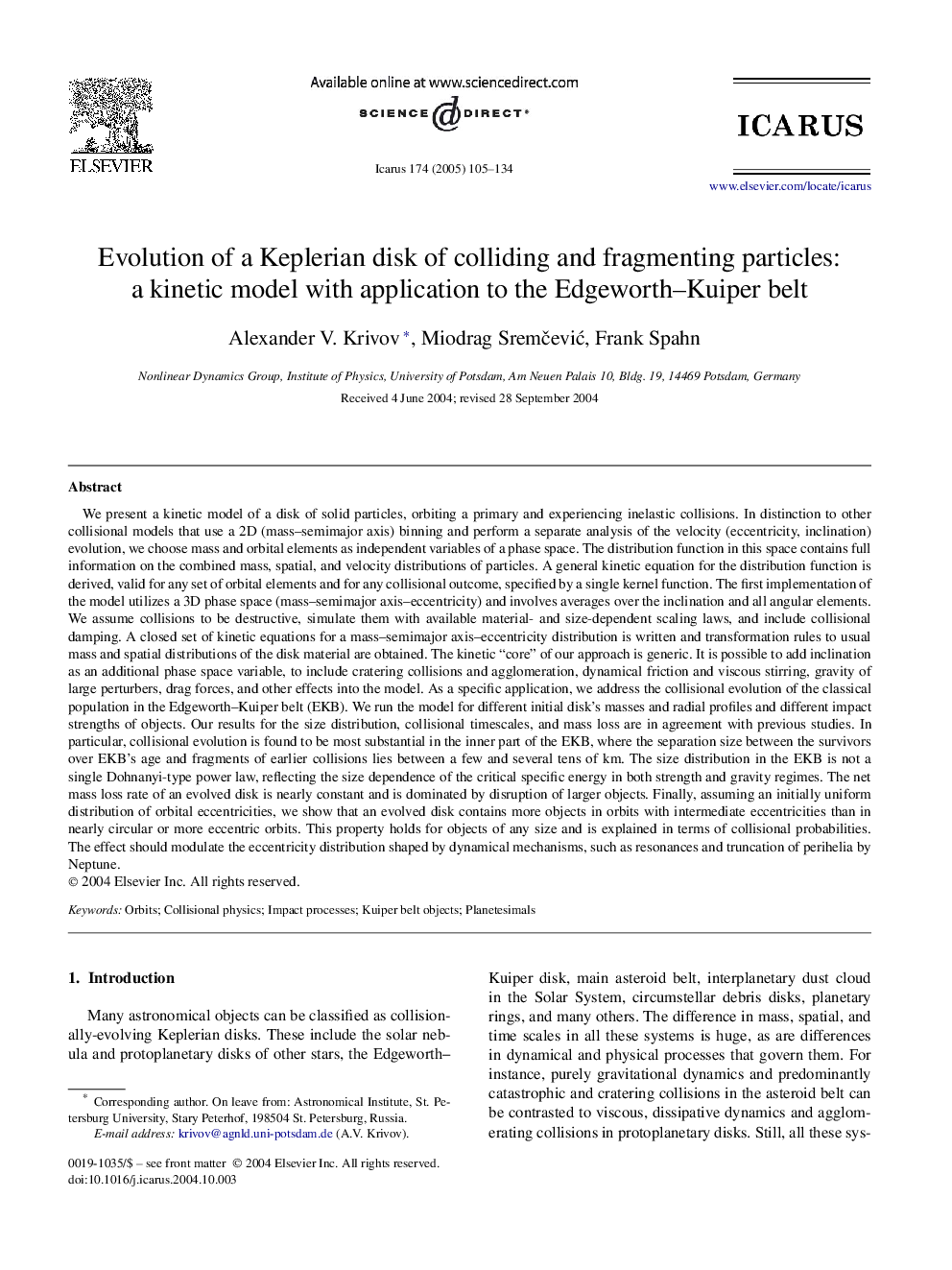| کد مقاله | کد نشریه | سال انتشار | مقاله انگلیسی | نسخه تمام متن |
|---|---|---|---|---|
| 10702257 | 1021235 | 2005 | 30 صفحه PDF | دانلود رایگان |
عنوان انگلیسی مقاله ISI
Evolution of a Keplerian disk of colliding and fragmenting particles: a kinetic model with application to the Edgeworth-Kuiper belt
دانلود مقاله + سفارش ترجمه
دانلود مقاله ISI انگلیسی
رایگان برای ایرانیان
کلمات کلیدی
موضوعات مرتبط
مهندسی و علوم پایه
علوم زمین و سیارات
علوم فضا و نجوم
پیش نمایش صفحه اول مقاله

چکیده انگلیسی
We present a kinetic model of a disk of solid particles, orbiting a primary and experiencing inelastic collisions. In distinction to other collisional models that use a 2D (mass-semimajor axis) binning and perform a separate analysis of the velocity (eccentricity, inclination) evolution, we choose mass and orbital elements as independent variables of a phase space. The distribution function in this space contains full information on the combined mass, spatial, and velocity distributions of particles. A general kinetic equation for the distribution function is derived, valid for any set of orbital elements and for any collisional outcome, specified by a single kernel function. The first implementation of the model utilizes a 3D phase space (mass-semimajor axis-eccentricity) and involves averages over the inclination and all angular elements. We assume collisions to be destructive, simulate them with available material- and size-dependent scaling laws, and include collisional damping. A closed set of kinetic equations for a mass-semimajor axis-eccentricity distribution is written and transformation rules to usual mass and spatial distributions of the disk material are obtained. The kinetic “core” of our approach is generic. It is possible to add inclination as an additional phase space variable, to include cratering collisions and agglomeration, dynamical friction and viscous stirring, gravity of large perturbers, drag forces, and other effects into the model. As a specific application, we address the collisional evolution of the classical population in the Edgeworth-Kuiper belt (EKB). We run the model for different initial disk's masses and radial profiles and different impact strengths of objects. Our results for the size distribution, collisional timescales, and mass loss are in agreement with previous studies. In particular, collisional evolution is found to be most substantial in the inner part of the EKB, where the separation size between the survivors over EKB's age and fragments of earlier collisions lies between a few and several tens of km. The size distribution in the EKB is not a single Dohnanyi-type power law, reflecting the size dependence of the critical specific energy in both strength and gravity regimes. The net mass loss rate of an evolved disk is nearly constant and is dominated by disruption of larger objects. Finally, assuming an initially uniform distribution of orbital eccentricities, we show that an evolved disk contains more objects in orbits with intermediate eccentricities than in nearly circular or more eccentric orbits. This property holds for objects of any size and is explained in terms of collisional probabilities. The effect should modulate the eccentricity distribution shaped by dynamical mechanisms, such as resonances and truncation of perihelia by Neptune.
ناشر
Database: Elsevier - ScienceDirect (ساینس دایرکت)
Journal: Icarus - Volume 174, Issue 1, March 2005, Pages 105-134
Journal: Icarus - Volume 174, Issue 1, March 2005, Pages 105-134
نویسندگان
Alexander V. Krivov, Miodrag SremÄeviÄ, Frank Spahn,